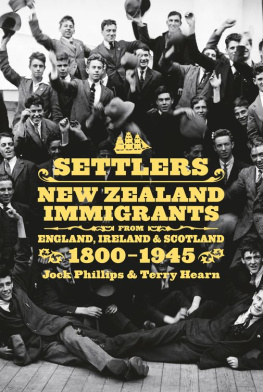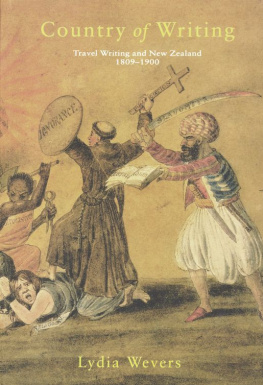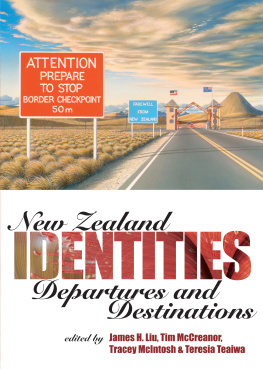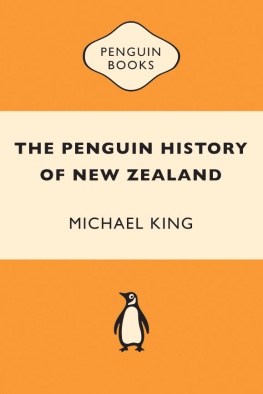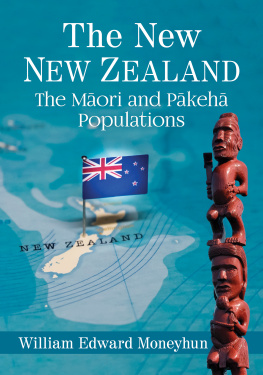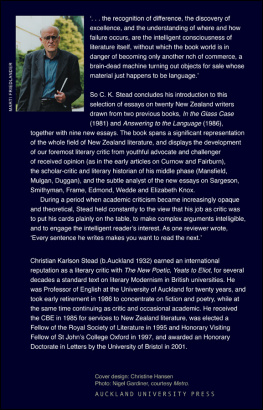The Settlers Plot
How Stories Take Place in New Zealand
Alex Calder
CONTENTS
Preface
This book is a study of the relationship between literature, place and the history of Pakeha settlement in New Zealand. By and large, each chapter explores one or more of the most frequently chosen settings in classic New Zealand literature the beach, the farm, the bush or the suburb and reflects on the plots or storylines that go with them. I believe the literary concept of setting gives us a new way of approaching Pakeha questions of place and identity. And putting setting and settlement together helps us to see that they are not uniquely our issues either they reappear, with differences, whenever and wherever an old world literary form takes a new world setting.
Settings are idealised versions of many actual places. They are locations that enable certain stories to be told and around which various aspirations and values take shape, are challenged and modified. Settings also have a complex relationship to our physical geography and to what Philip Fisher calls the hard facts of history. Some settings wear out and lose their magic; others are remarkably durable, revealing deeper continuities beneath our perceptions of change. Whenever a plot kicks in and events take place, a story will draw its own map and suggest others.
A primary purpose of this book is cartographic: I have tried to connect the way stories take shape in these settings to the actual history of Pakeha settlement. My idea comes from an illustration known as the brain homunculus: a model of the human figure spatially reorganised according to the distribution of nerve endings. From a minuscule trunk, like a genie emerging from a bottle, a large misshapen head with flabby lips and pendulous earlobes raises sunflower-sized hands from the stalks of each arm. What is the brain homunculus shape of the familiar map of New Zealand? We wont find it in any atlas, but we can imagine it insofar as poems, novels and stories are our nerve-ends.
All readers develop a sense of right relation between story and setting. A ghost story to give a quick illustrative example requires a haunted house, and while a New Zealand writer has a great deal of latitude as to where to situate that house, he or she is likely to follow (or pointedly disobey) a number of taken-for-granted but not always obvious rules. In our country, a haunted house is more likely to be suburban or rural than urban; no doubt this is because the inner city is culturally new while ghost stories require decay and ruin. A haunted house will perhaps feature an overgrown hedge or moonlit macrocarpas along a winding driveway. All ghost stories have an affinity with remote locations; more importantly, they need a threshold to be crossed. Nor will a haunted house be the single-storey dwelling most Kiwis live in: a proper ghost story needs an attic and a cellar as well as everyday rooms. One of our best gothic novels, David Ballantynes Sydney Bridge Upside Down, finds the functional equivalents of those spaces in a ruined freezing works. A haunted house must of course have a ghost but what kind of ghost? I have not conducted a census, but if you know how ghost stories work, you might expect the greater proportion of our literary ghosts to be Maori for, as Hamlet reminds us, it is the function of ghosts to voice wrongs from the past. (And in fact all ghosts in this book do turn out be Maori.) Settings, in other words, are highly conventional and highly suggestive places. I have tried to be the anthropologist of the tacit cultural knowledge Pakeha have invested in the most common settings in New Zealand literature; writing a cultural history of that knowledge forms a second part of the purpose of this book.
A third aim is to read a relatively small number of classic New Zealand texts closely and well. Rather than survey the field, I have opted to examine a few illustrative case studies in the hope that one or two detailed examples are worth a hundred cursory glances. While the time span extends from the late 1820s through to the early 2000s, I have by and large focused on classic rather than contemporary literature. This is not meant to be a hard-and-fast distinction. Perhaps it suggests two always-reforming boundaries: one separating books that still have a claim on our present from those whose moment has passed; another, looking forwards, distinguishing the literature we know from the literature we are still coming to know. The first part of the book, Belonging, sets a pattern of treatment more or less followed by the work as a whole: one text from the 1870s and another from the 1910s, a strongly contrasting text from the 1960s, but an introduction and a conclusion that anchor the whole discussion in the present moment. Part II, Landing, focuses on material from and about the cross-cultural frontier and deals with narratives set on the beach or in small Maori communities. Part III, Settling, investigates processes of settling/unsettling the land with a chapter on land deals and another on farming; the remaining chapters examine the New Zealand pattern of early suburbanisation and the development of forms of high culture associated with urban centres. The final part of the book, Looming, overlaps chronologically with earlier sections, and considers the role of distance and the importance of overseas as a place in New Zealand literary culture. Each of these sections is introduced separately.
The Settlers Plot is bound to relate to the notion of a canon and to received ideas about the development of New Zealand literature. Perhaps only four writers are currently regarded as irreplaceable in any book-length general consideration of New Zealand literature. They are Katherine Mansfield, Frank Sargeson, Janet Frame and Allen Curnow. That central configuration may change in time, but for the moment it seems uncontroversial to associate classic New Zealand literature first with those names, and then with several dozen other writers of considerable merit and accomplishment who are no longer living, or who are nearing the end of long and productive careers. Those four writers of course feature here, along with a necessarily restricted number from that bigger group, whose works have been chosen largely because they suit my purposes better than others. That said, I do have an ambition to change the canon. Unlike most studies of New Zealand literature, The Settlers Plot gives considerable space to non-fiction and to writing from the nineteenth century. The default setting for most comparable books is that literature means texts in the three genres of poetry, fiction and drama. That assumption is the main reason why our nineteenth-century literature has sometimes seemed so impoverished and why the flowering of New Zealand literary culture has so often been associated with the 1930s or later. If we include non-fiction, the picture of our canonical writing alters significantly. Two very remarkable writers F. E. Maning and Herbert Guthrie-Smith seem to me to rank alongside or just below that central group of four. Their books are by no means unfamiliar Old New Zealand and Tutira have remained in print almost continuously but they have received relatively little extended critical discussion. This book addresses that lack and shows how different our literary history looks when these writers are ascribed a central and defining place.
Given its title and subject matter, The Settlers Plot is a Pakeha book rather than a book that actively seeks to document Maori perspectives, though the influence of Maori is strongly registered throughout. Some years ago, Pakeha were properly nervous about appropriating Maori material; not quite so many years ago, Pakeha were properly nervous about failing to include a Maori perspective. Nowadays the mana of writing by Maori is evident and widely acknowledged. I have not felt obliged to add a special chapter and have respectfully left most of what I might have said about the Maori contribution to New Zealand literature at one side of my point which remains an account of Pakeha literary and cultural history from a Settlement Studies perspective. A word about this academic term: it is not the same as the study of literature by early settlers. It is a form of postcolonial inquiry interested in a distinct set of problems shared by nations founded on the settlement of a new but already populated world by modernising people from the old world. Its basic premise is that the foundational problems, injustices and consequences of European settlement of this country will not disappear though those problems can and often have been forgotten, underestimated or wished away.


